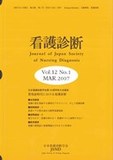Japanese
English
- 有料閲覧
- Abstract 文献概要
- 参考文献 Reference
本研究の目的は,NANDA看護診断の使用頻度と,各診断ラベルの関連因子について看護記録を分析することで,臨床での看護診断の実際と看護診断ラベルごとの患者の特徴を明らかにすることとした.大学附属病院の電子カルテにおいて,3か月間に記録された入院患者1,192名の看護記録に記入された看護診断ラベルとその関連因子,および患者の性別,年齢,疾患名を分析の対象とした.その結果,使用頻度の高かった診断ラベルは〈効果的治療計画管理〉〈セルフケア不足〉〈急性疼痛〉〈非効果的組織循環〉〈不安〉〈感染リスク状態〉であった.〈効果的治療計画管理〉の関連因子には初めて体験する入院や疾患・治療に関する項目が多く挙げられていた.他の診断ラベルの関連因子では,NANDAで示されていない項目も多く記載されていた.全体的に関連因子の表現が多岐にわたっていたことから,看護診断に関する概念理解の統一までには至っていないことが推測できた.このことより,個々の看護師が正確に看護診断を理解し使用していくためには,看護診断の用語に関する統一した正しい理解を促進する継続的な教育介入の必要性が示唆された.
The purposes of this study were to investigate clinical use of nursing diagnostic labels and their related factors, and to analyze patients' characteristics under each nursing label in nursing records. The data were collected from 1,192 patient charts which were recorded during a 3 month period in a university hospital. The data included nursing labels and their related factors, and patients' characteristics. All data were anonymously collected and stored in secure place. Frequently used diagnostic labels were Effective therapeutic regimen management, Self-care deficit, Acute pain, Ineffective tissue perfusion, Anxiety, and Risk for infection. Frequently stated related factors for Effective therapeutic regimen management were newly-experienced events such as hospitalization, newly diagnosed, or receiving treatment. Related factors for other diagnostic labels were recorded in detailed terms rather than general terms. In conclusion, nurses should improve conceptual knowledge on nursing diagnoses as a standardized language system.
Copyright © 2007, Japan Society of Nursing Diagnosis. All rights reserved.


